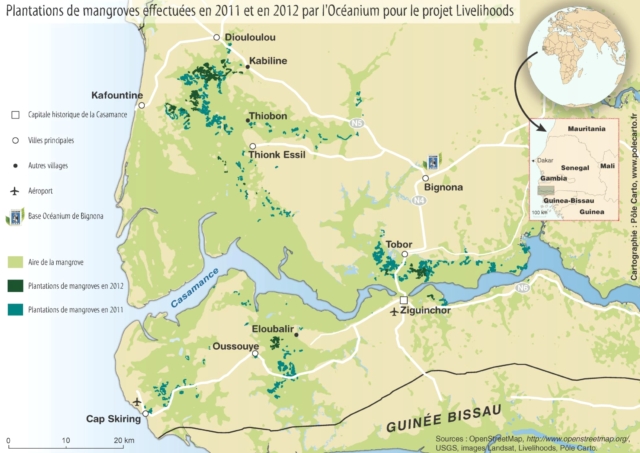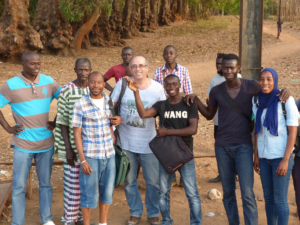 [1]
[1]In March 2018, Laurent Chazée represented the Tour du Valat in Casamance, where he launched field work that will measure the human impacts of planting more than 10,000 hectares of mangroves (native species Rhizophora sp.) between 2009 and 2012 in over 450 villages. Beyond the restoration of the mangroves and the monitoring of carbon sequestration, the goal is to understand the economic, social and cultural impacts the restoration of these ecosystems has had on local populations.
This mangrove planting project in Senegal, which is backed by the Livelihoods Carbon Fund, an impact investment fund that uses carbon savings to restore ecosystems and improve the standards of living of rural communities, aims to recreate an ecosystem that will protect arable land from salinisation and produce food resources (fish, shellfish, and crustaceans) and wood. The Senegalese NGO Oceanium, which has been active in the restoration of mangroves since 1984, has developed this project in the field and is monitoring its progress.
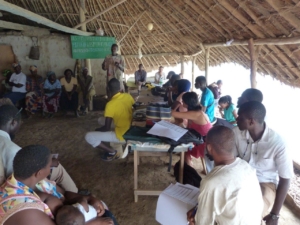 [2]
[2]The Livelihoods Carbon Fund also finances the monitoring of this project over a 20-year period up to 2029. Now that the project is almost at its mid-point, the Livelihoods Fund has called on the Tour du Valat to assess the benefits the replanting of mangroves has generated for local communities.
The Tour du Valat’s mission is organised according to its ‘Livelihood’ methodology, which was developed in 2017 and lasted three months. During the 10 days of field work (14-24 March), the mission organised the training of the 15 people in charge of the surveys and of the field observations. It developed and tested questionnaires in three communities and several households, which are among the 50 villages and 1000 households selected in the sampling for the assessment of the impacts. The sampling took account of the geographic distribution, the percentage of mangroves restored per village, the levels of poverty and well-being, and the cultural and ethnic considerations that are particularly important in this region.
The regular restitution of results with the local team made it possible to ensure that there was a common understanding of the approach, to adjust the questionnaires to the local terminologies, and to verify and improve the quality of the data collected. Following this period of fieldwork, the Tour du Valat will be involved with Oceanium in analysing the impacts.
Before the end of the year, the Livelihoods Carbon Fund, Oceanium and the Tour du Valat will share the lessons learned in this study with others. These lessons from the Tour du Valat’s ‘Livelihood’ method may prove to be useful for the restoration of Mediterranean wetlands that are inhabited and used by people.
For more information:
What is a mangrove?
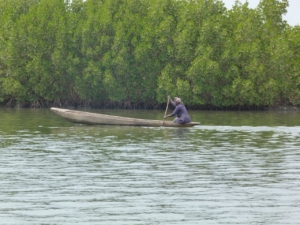 [3]
[3]A natural barrier against tsunamis, immense biodiversity reservoir, and natural ‘supermarket’ for some populations, a mangrove is a wetland, a fragile ecosystem typically found in tropical coastal areas, a forest between land and sea. Mangroves, which are principally comprised of mangrove trees (with an intertwined root system), are located in intertidal areas, and are very useful for the protection of land and for increasing seafood production (shrimp and fish).
Why is it so important to conserve mangroves?
The preservation of mangroves is fundamental, because they provide important services: they stabilise coastal areas and help to fight against erosion. They retain the finest sediments and thereby limit the silting of bays (they also absorb the pollutants found in the sediments they retain). They permit the breeding of ichthyic fauna (fish), and serve as fish nurseries. Finally, they maintain microclimates, and are excellent areas for activities linked to tourism, while also providing excellent forest and fish resources.
History of the project:
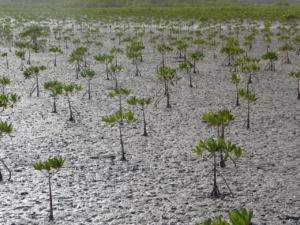 [4]
[4]Between 2009 and 2012, the mangrove replanting project in the estuaries of Casamance and Sine-Saloum in Senegal helped 450 villages replant more than 10,000 ha of mangrove trees in the 185, 000 ha of mangroves. It was carried out in the 45, 000 ha of mangroves lost since the 1970s due to drought and the decrease in freshwater (linked to its upstream use for farming, the deforestation of mangroves, as well as the gathering of firewood, rice growing, salt pans, and the configuration of road infrastructure that blocks the flow of freshwater and saline water). This loss of mangroves has also resulted in a decrease of fish stocks. This replanting programme concerned 3,200 parcels, and more than 100,000 volunteers participated in it.
This project is backed by the Livelihoods Carbon Fund, an impact investment fund supported by 10 private corporations: Crédit Agricole, Danone, Firmenich, Groupe Caisse des Dépôts, Hermès, La Poste, Michelin, SAP, Schneider Electric, and Voyageurs du Monde. This fund finances project developers like Oceanium so they can restore mangroves, promote agroforestry, and distribute improved cookstoves in Africa, Asia, and South America. The projects are conducted for 10 to 20 years. In return for their investments, the corporations that support the fund receive carbon credits certified by the best international standards. The measurement and monitoring of the impacts of the project in the local communities, conducted by the Tour du Valat, are complementary to the carbon sequestration monitoring.
